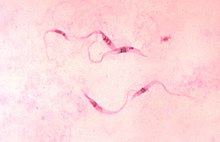Kinetoplastida
| Kinetoplastida | |
|---|---|

| |
| Trypanosoma cruzi parasites | |
| Scientific classification | |
| Domain: | Eukaryota |
| Phylum: | Euglenozoa |
| Subphylum: | Glycomonada |
| Class: | Kinetoplastea Honigberg, 1963 emend. Cavalier-Smith, 1981[1][2] |
| Subdivisions | |
| Synonyms | |
| |
Kinetoplastida (or Kinetoplastea, as a
The kinetoplastids were first defined by
Taxonomy
History
Honigberg created the taxonomic names Kinetoplastida and Kinetoplastea in 1963.[1] Since then there is no consensus on the use of either of the two as a definite taxon. Kinetoplastea is more widely used as the class,[6][7][8][9][10] while Kinetoplastida is mostly used to designate the order,[4][11][12][13] but is also used as a class.[3][14] Lynn Margulis, who initially accepted Kinetoplastida as an order in 1974, later placed it as a class.[15] Use of Kinetoplastida as an order also creates confusion as there is already an older name Trypanosomatida Kent, 1880, under which the kinetoplastids are most often placed.[16]
Classification
Kinetoplastida is divided into two subclasses - Metakinetoplastina and Prokinetoplastina.[17][18]
- Family ?Bordnamonadidae Cavalier-Smith 2013
- Family ?Trypanophididae Poche 1911
- Subclass Prokinetoplastina Vickerman 2004
- Order Prokinetoplastida Vickerman 2004
- Family Ichthyobodonidae Isaksen et al. 2007
- Order Prokinetoplastida Vickerman 2004
- Subclass Metakinetoplastina Vickerman 2004
- Order Neobodonida Vickerman 2004
- Family Rhynchomonadidae Cavalier-Smith 2016
- Family Neobodonidae Cavalier-Smith 2016
- Order Parabodonida Vickerman 2004
- Family Parabodonidae Cavalier-Smith 2016 [Cryptobiaceae Poche 1911; Cryptobiidae Vickerman 1976; Trypanoplasmatidae Hartmann & Chagas 1910]
- Order Bodonida Hollande 1952 emend. Vickerman 1976
- Family Bodonidae Bütschli 1883
- Order Trypanosomatida Kent 1880 stat. n. Hollande 1952 emend. Vickerman 2004
- Family Trypanosomatidae Doflein 1901 [Trypanomorphidae Woodcock 1906]
- Order Neobodonida Vickerman 2004
Morphology
Kinetoplastids are
Mitochondrion and kinetoplast DNA
The kinetoplast, after which the class is named, is a dense DNA-containing granule within the cell's single mitochondrion, containing many copies of the mitochondrial genome. The structure is made up of a network of concatenated circular DNA molecules and their related structural proteins along with DNA and RNA polymerases. The kinetoplast is found at the base of a cell's flagella and is associated to the flagellum basal body by a cytoskeletal structure.[citation needed]
Cytoskeleton
The cytoskeleton of kinetoplastids is primarily made up of
Flagella
All kinetoplastids possess at least one flagellum; species in the order trypanosomatida have one and bodonida have two. In kinetoplastids with two flagella most forms have a leading and trailing flagellum, the latter of which may be attached to the side of the cell. The flagella are used for locomotion and attachment to surfaces. The bases of the flagella are found in a specialised pocket structure which is also the location of the cytostome.[citation needed]
Life cycle
Kinetoplastids may be free-living or parasitic. The order trypanosomatida is notable as it includes many genera which are exclusively parasitic. Trypanosomatids may have simple life cycles in a single host or more complex ones which progress through multiple differentiation stages in two hosts. Dramatic morphological changes are possible between lifecycle stages. Diseases caused by members of the order trypanosomatida include sleeping sickness and Chagas disease, caused by species of Trypanosoma, and leishmaniasis, caused by species of Leishmania. Trypanosoma brucei can undergo meiosis as a likely part of a sexual cycle.[19][20] Leishmania major is also capable of a meiotic process that is likely part of a sexual cycle.[21]
Gallery
-
Cryptobia sp.
-
Bodosp.
-
Trypanosoma sp.
References
- ^ a b c Honigberg, B. M. (1963). "A contribution to systematics of the non-pigmented flagellates.". In Ludvík, J.; Lom, J.; Vávra J. (eds.). Progress in Protozoology: proceedings of the first International Congress on protozoology held at Prague. Academic Press.
- ^ Cavalier-Smith, T. (1981). Eukaryote kingdoms: seven or nine? Biosystems 14, 461–481.
- ^ ISBN 978-0-12415-895-5.
- ^ a b "Kinetoplastida (kinetoplasts)". UniProt Consortium. Retrieved 22 January 2015.
- ^ Lukes, Julius (2009). "Kinetoplastida". The Tree of Life Web Project. Retrieved 10 September 2013.
- ^ "Kinetoplastea". EOL. Retrieved 22 January 2015.
- ^ "Kinetoplastea". World Register of Marine Species. Retrieved 22 January 2015.
- ^ "Kinetoplastea". ZipcodeZoo. Archived from the original on 22 January 2015. Retrieved 22 January 2015.
- ^ "Taxon: Class Kinetoplastea". The Taxonomicon. Archived from the original on 22 January 2015. Retrieved 22 January 2015.
- PMID 15388756.
- ^ "Kinetoplastida". EOL. Retrieved 22 January 2015.
- ^ "Kinetoplastida". Metalife. Archived from the original on 22 January 2015. Retrieved 22 January 2015.
- ^ "Kinetoplastida". NCBI Taxonomy. Retrieved 22 January 2015.
- ISBN 978-0-1951214-38.
- ISBN 978-0-12-373621-5.)
{{cite book}}: CS1 maint: multiple names: authors list (link - PMID 21030427.
- PMID 15388756.
- PMID 18814685.
- PMID 21321215.
- PMID 26027775.
- PMID 19359589.
Bibliography
- Lumsden, W.H.R. & D.A. Evans (eds.). 1976-1979. Biology of the Kinetoplastida, 2 vols. London: Academic Press.



